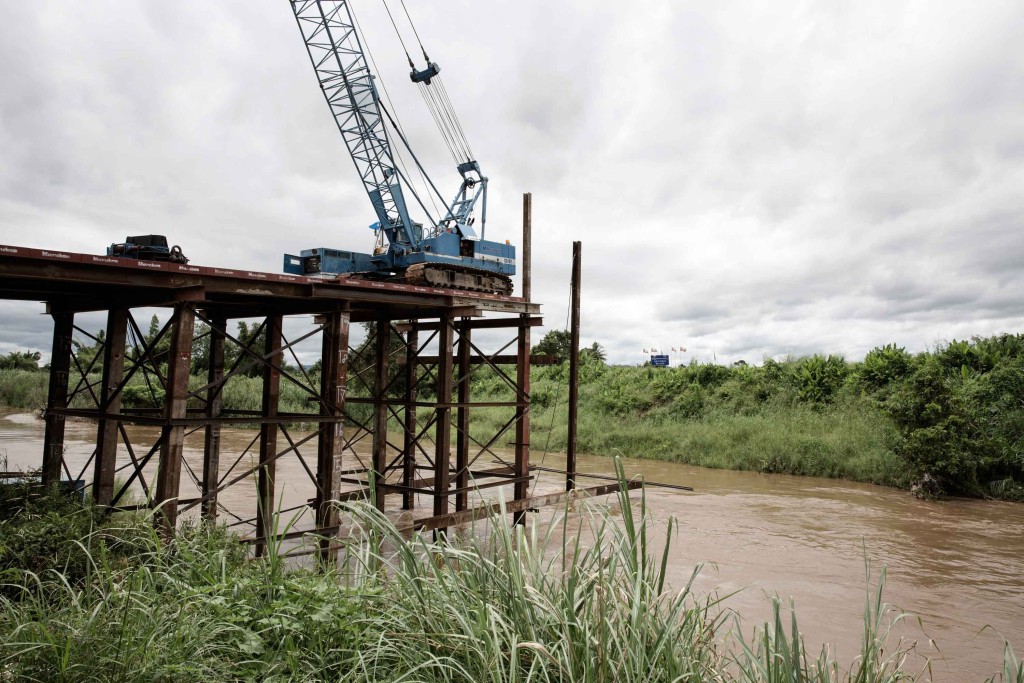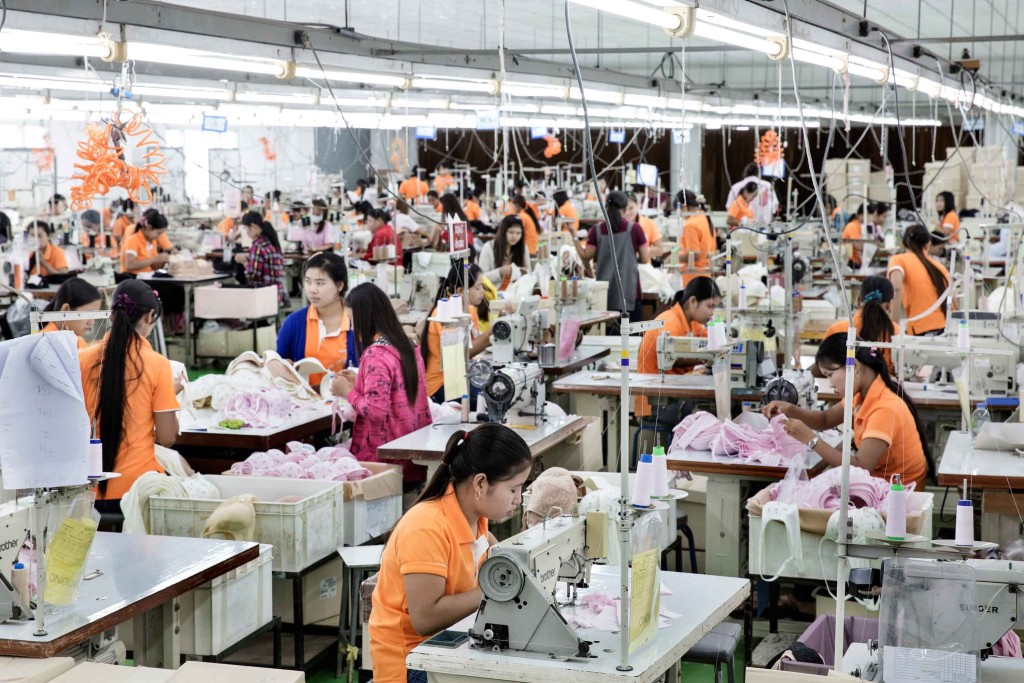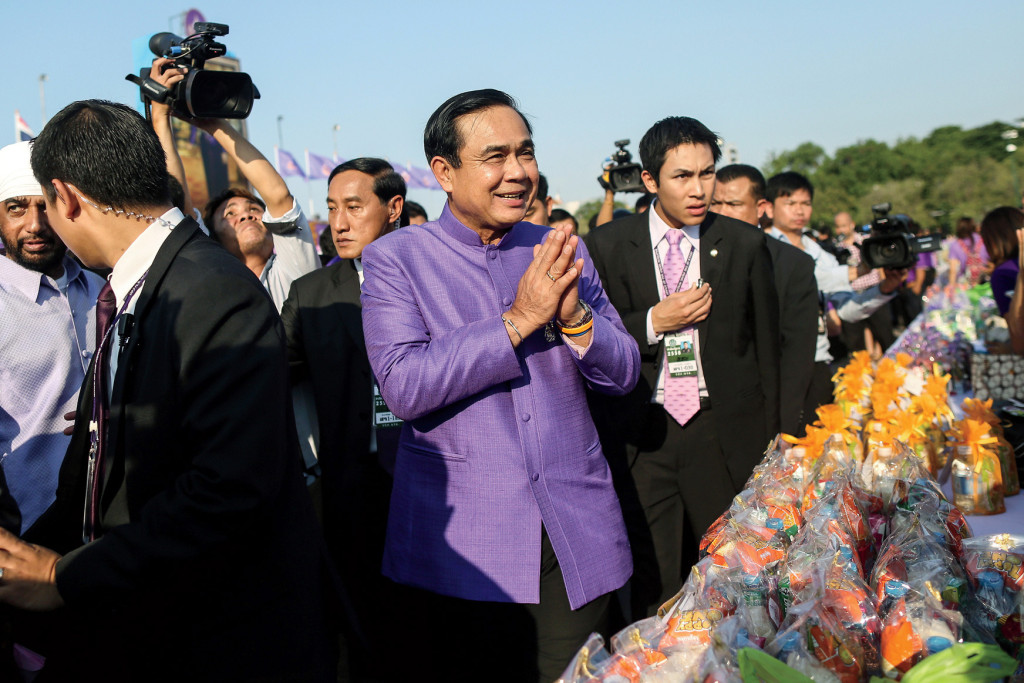Prayuth Chan-Ocha, the general who runs Thailand, wants to turn once unruly border regions into zones of economic prosperity.
For much of the past century, the Thai border town of Mae Sot stood on one of Asia’s wilder frontiers.
On the opposite bank of the swirling, mud-brown Moei River in neighboring Myanmar, Karen insurgents waged a seemingly endless independence war. Smugglers trafficked guns, opium, timber, and gemstones. Then there was the two-way human cargo during the past three decades: 120,000 battle-scarred refugees seeking sanctuary in Thailand, battle-hardened mercenaries heading in the opposite direction.
Prime Minister Prayuth wants to turn now-peaceful battlefields into prosperous marketplaces. Photograph: Dario Pignatelli/Bloomberg
In this unlikely outpost—and others like it along Thailand’s 5,673 kilometers (3,523 miles) of borders—Prayuth Chan-Ocha, the general who runs Bangkok’s ruling military junta, is making a big bet: that he can turn former war zones into some of Southeast Asia’s most prosperous marketplaces. He’s doing it by creating 10 special economic zones that offer tax breaks and other incentives to investors venturing into now-peaceful border areas close to fast-growing Myanmar (formerly known as Burma), Vietnam, Cambodia, and Laos.
Low taxes are only part of the allure. Relying on a mix of government revenue, bond sales, and other funding, Prayuth plans to spend $83 billion over seven years on new railways, roads, and customs posts to establish cross-border trade routes. The idea is to link some 2.4 billion consumers in China and India with Asia’s newest economic grouping, the ASEAN Economic Community, of which Thailand is a member. The 10-nation Southeast Asian common market, which opens for business next year, boasts a combined economy of $2.3 trillion and a population of 625 million.
To handle increased traffic, the Thai government is building a four-lane bridge to Myanmar. Photograph by Guilio Di Sturco/Bloomberg Markets
As well as sitting at the heart of the AEC, Thailand is less than 200 kilometers from China at its closest point. Across the river from Mae Sot, a city of 100,000, Myanmar provides a potential land bridge to India. Prayuth is determined that his country of 68 million people—despite a torrid recent political history of coups and chaos—will become the region’s investor-friendly communications, trade, and logistics hub. “We have cleaned up our home to accommodate investors,” says Atchaka Sibunruang, a longtime civil servant whom Prayuth appointed industry minister in August in a major government reshuffleaimed at reinvigorating growth.
Investors are taking note. Japanese and Chinese companies are competing to bid for some of the most strategic rail projects. Japanese firms are even eager to construct a line that would partly replicate the route of the World War II Thailand-Burma Death Railway immortalized on film in The Bridge on the River Kwai.
Thailand, Southeast Asia’s second-biggest economy, is highly dependent on exports. It’s one of the world’s major suppliers of products as diverse as hard disk drives, automobiles, rice, and canned tuna. But since Prayuth seized power in May 2014, total exports have declined as global growth slowed and commodities prices plunged. According to government projections, shipments this year will slide 5 percent, while gross domestic product growth will be 2.8 percent, one of the slowest rates in Southeast Asia.
Consumer confidence fell for the first nine months of this year before edging up in October, household debt is rising, the workforce is aging, and an El Niño–triggereddrought has hit one-third of Thailand’s 76 provinces, potentially damaging as much as 30 percent of the rice crop. A bomb that exploded in central Bangkok in August, killing 20 people, cast a pall over Thailand’s booming tourism industry, which accounts for 10 percent of GDP.
Then there’s QUICKTAKEpolitical gridlock. When Prayuth overthrew the elected government following months of turmoil, he promised a swift return to civilian rule. More than 18 months later, no election date has been fixed. An impending royal succession has further clouded the country’s future. The revered King Bhumibol Adulyadej, who turns 88 on Dec. 5, is the world’s longest-reigning monarch, having ascended to the throne in 1946. Now, he’s ailing and seldom seen in public. His heir is Crown Prince Maha Vajiralongkorn, 63.
Against this backdrop, Thai border trade looks promising. It’s surging as less developed neighboring countries’ economies expand at more than double, even triple, Thailand’s pace. In the first eight months of 2015, Thai sales to Myanmar, Vietnam, Cambodia, and Laos jumped 8.1 percent to $14.5 billion. That accounted for 10 percent of Thailand’s total exports. Mae Sot is setting the pace, with cross-border trade in 2014 close to $2 billion, a 250 percent increase over three years earlier.
Special economic zones in Asia are nothing new. In the 1980s, China’s reformist leader Deng Xiaoping set up five of them—including the border boomtown of Shenzhen, adjacent to Hong Kong—to help kick-start what is now the world’s second-largest economy. While Mae Sot is no Shenzhen, it stands just 100 meters (330 feet) across the Moei from Myanmar, a once-isolated country of 54 million that’s undergoing a helter-skelter political and economic transformation.
Once one of the world’s poorest countries, Myanmar will grow at 8.5 percent this year, according to the World Bank. That’s faster than even China or India. Equally significant, Mae Sot is located almost precisely midway between Bangkok and Myanmar’s largest city, Yangon, formerly known as Rangoon. It also straddles a planned east-west rail and road corridor linking the Vietnamese port of Danang with the Indian subcontinent via Laos, Thailand, and Myanmar. “Today, Mae Sot is just a district, but it will become a great city,” says Chaiya Yimwilai, a U.S.-educated vice minister in Prayuth’s office.
Workers toil over sewing machines at a Saha Pathana factory in Mae Sot. Photograph by Guilio Di Sturco/Bloomberg Markets
Nascent signs of that are already apparent in Mae Sot. On the outskirts, a four-lane bridge to Myanmar is under construction to complement the two-lane structure that can handle only a fraction of the present trade. On a street once lined by simple so-called shop houses, a supermarket owned by the Thai unit of the British retail giant Tesco sprawls over a downtown block. Property prices have soared 500 percent in 10 years, according to the local chamber of commerce. Recent developments include upmarket apartments such as the unsubtly named Rich Condo.
The seriously rich Dhanin Chearavanont, billionaire chairman of Bangkok-based Charoen Pokphand Group, is building an industrial estate down the road. Another publicly listed company, Bangkok-based Saha Pathana Inter-Holding, has already opened one. Its modern, air-conditioned factories are a far cry from the Asian sweatshops of yesteryear. Young immigrant women from Myanmar, immaculately dressed in traditional saronglike longyis, turn out Guy Laroche handbags, Arrow shirts, Polo socks, and the like.
Down on the Moei riverbank, the Veerasomkiat family—which 10 years ago struggled to earn a living trading chilies, shallots, and the headache-inducing food additive monosodium glutamate—loads river barges with cars destined for the Myanmar market. The number of vehicles shipped by its company, Klang 9 Logistics, has risen from 1,000 a month in 2009 to 3,000 per month now. Admittedly, many of them are refurbished secondhand Japanese family sedans. “But these days we are also shipping some brand-new Ferraris, Rolls-Royces, and Bentleys,” says Papawadee Teamjaijarean, 37, who helps her father, Surachai Veerasomkiat, run the business.
Barges used today may be replaced by land transport tomorrow as Presidents Xi Jinping of China and Narendra Modi of India plan new roads and railways that will meet up with the networks Thailand is building. “Being at the center of the region, Thailand has advantages other countries don’t have,” says Chompoopen Sirithorn, who helps manage $36 billion for the Social Security Office, Thailand’s biggest pension fund. “The border trade is its one bright spot and will attract overseas investors.”
Former Glencore International Chairman Simon Murray says he will be watching Thailand’s new border economic zones closely but cautiously. Hong Kong–based Murray has investments in Myanmar ranging from an oil services company to a distillery that produces a 43-percent-proof local whiskey named High Class. He hopes to export spirits overland through Thailand but notes that the border trade depends on continuing warming political relations between former enemies. Thais have never forgotten that invaders from Myanmar sacked the then–Thai capital, Ayutthaya, in 1767.
And more-recent conflicts, between the Myanmar central government and a dozen ethnic rebel groups, including the Karen across the border from Mae Sot, have been papered over by tenuous peace treaties. During the Vietnam War, which ended in 1975, Thailand sided with the U.S., letting it bomb Vietnam, Cambodia, and Laos from Thai bases. “There’s a lot of potential but also a lot of history,” says Murray, whose firm, Simon Murray & Co., is backed by Asia’s richest man, Li Ka-shing.
That said, the lure of Mae Sot seems likely to win over Taiwanese businessman Chia-tse Lee, 60, president of Taipei-based Danee Silk International. Lee owns one silk factory in China’s Zhejiang province. Now, he says, Mae Sot could be the site of his next expansion. “There is more energy here,” he says during an interview in Mae Sot. Although much of Mae Sot’s labor comes from across the border in poorer Myanmar, local businesses still pay the minimum daily rate of 300 Thai baht ($8.50).
In a country with one of the world’s lowest unemployment rates—0.78 percent—a chronic labor shortage means few Thais are interested in such jobs. But the pay is enough to lure the likes of Ma Cherrg, 24, a university graduate from Myanmar, to swap her law books for a slot on a Mae Sot production line. “This place is good to work, and it is also safe,” she says, referring to the fear of human trafficking that still pervades wilder border areas.
Life on the Thai-Myanmar border is still grim for many, as a visit to physician Cynthia Maung’s Mae Tao Clinic in Mae Sot testifies. Maung, 56, fled Myanmar in 1988 after the then–ruling generals brutally put down Aung San Suu Kyi’s democracy movement. Today, backed by donors such as investor George Soros, she treats for free many of the 120,000 refugees still fearful of returning home and, increasingly, immigrant workers who have missed out on Mae Sot’s boom. “The peace process in Myanmar is still very fragile,” she says. “And with land becoming so expensive in Mae Sot, the poor get poorer.”
Despite the city’s success so far, even the generals who seized power in the 2014 coup are hedging their bets. In September, the government announced tax breaks to attract investors to more-developed parts of the country. They also earmarked two popular tourist destinations, the resort island of Phuket and the historic walled northern city of Chiang Mai, as potential technology hubs. “Talented people in the software industry would like to live in a beautiful environment so they can think better,” says Industry Minister Atchaka. Until that happens, though, adventurous investors may find more opportunities on Thailand’s once-wild frontiers.
Source: http://www.bloomberg.com/news/articles/2015-11-08/thailand-s-ruling-general-bets-83-billion-on-taming-borderlands



